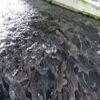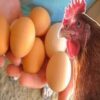In this article, we will be addressing the need and importance of proper housing of sheep and goats to ensure best performance records and profits. In the tropics indeed elsewhere it is not common practice to house sheep/goats in special buildings as this is of little practical value to traditional rural rearers.
Even in advanced countries, it is within the past three decades that attempts to house sheep and goats permanently in environmentally controlled conditions have been carried out to enable round-the-year production of lambs by the provision of artificial lighting patterns which enables ewe to produce up to two sets of lambs per year. If sheep rearing is considered about improved husbandry then the construction of a sheep house becomes essential.
Importance of Sheep and Goats Housing
Some of the importance of sheep/goat houses are briefly discussed in the following sub-sections:
1. Protection from adverse weather condition
The major function of a sheep/goat house is to protect the animal from adverse climatic conditions such as sunshine, rain, wind, or cold.
For the most part adult sheep/goats are equipped to withstand cold due to heat produced by the fermentation process but young lambs/kids have not yet developed this mechanism and should, therefore be protected sheep/goats do not like being drenched by heavy rain, nor excessive such particularly when the sun is at its height.
These can be seen by the attempts the animals make to seek shelter from excessive sun or rain.
2. Better Surveillance
When sheep/goats are kept together in a house, the owner can better observe them. He is therefore in a better position to notice sick animals and treat them appropriately before the disease is spread.
3. Protection from Predators
By the provision of a house, sheep/goats are protected from predators such as dogs, snakes, thieves, accidents, and other harmful vices.
4. Easy handling
Handling is easier, animals can be caught, and flock management is improved because it allows for certain management practices such as the isolation of rams outside the breeding season and weaning to be carried out. Other management practices such as identification docking and castration can be done easily.
5. Feeding of supplements is easier
This is so because animals of the same age or same physiological state such as yearlings, gestation, and fattening weaning can be kept in the same group. This improves performance since each animal receives a supplement meant to meet its particular production requirement.
Construction Materials for Housing of Sheep and Goats

There are several materials in the market available for the construction of a sheep and goat house. The major underlying factor is the resource (money) available to the farmer hence the often use of concrete.
However, galvanized iron and wire netting should not be regarded as the optimum as sheep and goat houses made of such materials do not necessarily produce the best animals. Good performance records have been obtained from sheep and goats housed in thatched roofs supported with brushwood.
Additionally, there is no universal solution to the best housing for your sheep and goats as natural materials easily available to the farmer which can be renewable at low cost seem better suited to our dear farmers if that is what.
It is not the materials used that determine whether a sheep/goat house is modern or traditional but the design, sitting, care taken in its construction, and above all, the way the house is maintained. Local materials available include palm, straw, mud, gathered floor banana leaves, bamboo, rope, planks, etc.
Read Also: Feeding Materials for Ruminant Animals
Covered shelter with a yard
This appears to be the best kind of housing for our sheep and goats given the climatic conditions, nature of sheep and goats, and economic condition of most farmers. While the covered house protects from adverse climatic conditions the yard provides space for exercise. Most times except in very wet conditions drinkers and feeding troughs can be left in the yard.
The sheep and goat house should not be sited in a wet, water-logged area. The house should be built on firm, even ground with a slight slope to allow rainwater to run off.
Since sheep and goat houses are sources of unpleasant odors, noise, and flies should not be built in densely populated areas. As much as possible especially in fairly large flocks, it should be on the outskirts. With the shepherd’s house following the sheep’s house at the same site.
The roof of the covered house should descend to a height of 1-1.20m above the ground level to protect it from wind. The ridge should then be at a height of 1-8.2m. This is sufficient to allow the shepherd access to the house.
If the post is made of brushwood, resistance varieties should be used so that they won’t be easily damaged by insects or get rotten. Such wood should be treated with waste oil to prevent attack by insects and inserted into a concrete base which should protect them from soil moisture space requirements for various classes of sheep are:
- Adult 0.20 – .040m2.
- Ewe with lamb 0.30 – .0.50m2.
- Young sheep 0. 15 – 0.20m2.
- Ram 0.50 – 0.75m2.
Space required for the yard should be calculated based on 2 m- 3 m2 per head. The minimum height of the yard should be 1m.
Please kindly note that the space required for animals in the covered house is given for tropical conditions where animals are not expected to stay in the house for any appreciable length of time.
Several such yards can be located alongside each other if several blocks must be separated. It is important to provide a gate with a width of about 2m to avoid jostling which occurs when sheep/goats leave or enter the yard.
Read Also: Nutrient Requirements and Feeding of Ruminants
Lambing/Kidding Unit
This is an area used to isolate pregnant ewes/does a few days to and after lambing/kidding. This allows for close monitoring of the lambing/kidding unit for 3-4 days. This is to enable close observation of both the dam and the lamb/kid and to ensure that the lamb/kid has obtained colostrums from the dam.
When constructing the lambing/kidding unit the number of sheep/goats in the flock should be taken into consideration, as the method of breeding and body size of the breed.
A feeding rack and water trough should be available. An unlimited supply of feed and water to the dam in the lambing/kidding unit is important where this is not available, the dam should not be taken there.
A high level of hygiene should be maintained in the lambing/kidding unit. The bedding used should be renewed after each lambing/kidding and burnt particularly if the floor is rammed earth.
Sheep and Goat Handling Unit
An essential requirement for all sheep and goat farms is an efficient handling unit, including a race, dipping tank, and footbath. This should be designed in such a way as to allow all operations to be done quickly. With the minimum number of helpers and an absence of stress and training on both men and animals.
Procedures carried out in the handling unit are: dipping, spraying, care of the feet, closing and inoculation, and dragging. All handling systems comprise the following features:
- A gathering large enough to take all the sheep to be dealt with at one time.
- A forcing pen – This acts as a funnel to the race i.e. the narrow passage in which sheep are forced into a single file with gates to enable sheep to be sorted out into separate pens.
- A dipping bath with a draining pen.
- A footbath.
- Handling or treatment pens.
- Holding or drafting pens into which sheep pass after treatment and sorting.
- Handling unit should be sited centrally to grazing areas, free draining, shaded, and convenient for access and loading. All construction must be free of sharp edges. The working area should be rooted to assist in the operations that must be carried out under all conditions.
In summary, the provision of adequate housing is necessary for sheep and goat production if improved productivity is to be achieved. Different construction materials are available. The resources available to the farmer and his environment determine what he uses. In the tropics, a covered house with a yard is considered sufficient.
Read Also: Water Emergency and Water Security






